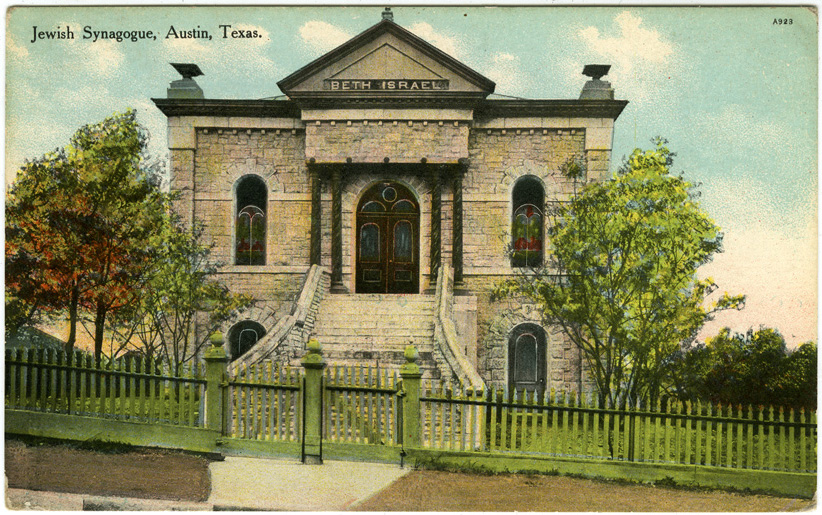3.4 Austin, Texas
Beth Israel, 11th Street and San Jacinto Boulevard
Architect unknown, 1884
Tobin’s Bookstore, Austin, Texas, publisher; no date
This postcard shows the first building of Congregation Beth Israel (House of Israel), the oldest congregation in Austin, Texas, founded on September 24, 1876, by a group of 30 Jews gathered at Odd Fellows Hall. Reporting on the inaugural gathering, the Weekly Democratic Statesman commented: “All the larger cities of Texas have their temples for Jewish worship, and we can see no reason why Austin should not keep company with them.”1
In May 1877, the new congregation bought a building site at 11th Street and San Jacinto Boulevard for $2,500, and, in 1879, applied to the state legislature for a charter. Among other fundraising events, a “Grand Masquerade Ball” was held at Millett Opera House in 1880. Construction of the synagogue proceeded by fits and starts and was not completed until 1884.
An austere two-story stone block, the synagogue looked like a secular meeting hall, except for the large exterior stairway that led to the main entrance on the second floor where the sanctuary was located. On each side of the arched entryway were two slender columns. These, set flush against the wall, carried a projecting block that in turn carried a pediment with the words “Beth Israel” carved along the bottom. To the right of the exterior stair on the ground level was a narrow, arched doorway that led to the basement level.
As with other congregations, building funds were raised from within the congregation. The Hebrew Ladies Society purchased the first ark for $120 and individual members contributed $150 or more for pews. When the first wedding took place in the temple in March 1885, Elias Krohn, who married Goleye Melasky, donated carpets for the temple’s aisles.
After World War II, the congregation grew to 95 members, including many children. To accommodate them, rooms were added to the basement Sunday school. Still the building was too small. By 1953, the congregation had 225 members and 96 religious school students. During the High Holidays, when the full congregation stood up and sat down, the building shook, indicating structural problems. The congregation decided to find a new home, purchased a horse pasture in northwest Austin, and built a new synagogue near the present intersection of Shoal Creek Boulevard and 38th Street. In 1957, a social hall, administrative wing, and chapel were completed, and, ten years later, a 650-seat sanctuary was built.
Everything was moved from the old temple except the pews, the yahrzeit memorial plaques bearing names of deceased members of the congregation, and the organ. The stained glass windows were stored. They disappeared but were found years later at a flea market and were duly installed in a chapel of the new synagogue in 1987 when an administrative wing was added to the building.
In the late 1990s, after a contentious series of votes over whether to relocate to a 40-acre site in northwest Austin established for the Jewish community by philanthropists Michael and Susan Dell, about a third of the membership withdrew, formed another Reform congregation called Beth Shalom, and moved to the new Dell Campus. Still, because of Austin’s booming economy and population growth, Beth Israel soon regained its membership numbers and, in 2008, remodeled its 1967 sanctuary.
1 “The word synagogue. . . .” Weekly Democratic Statesman, September 28, 1876.
